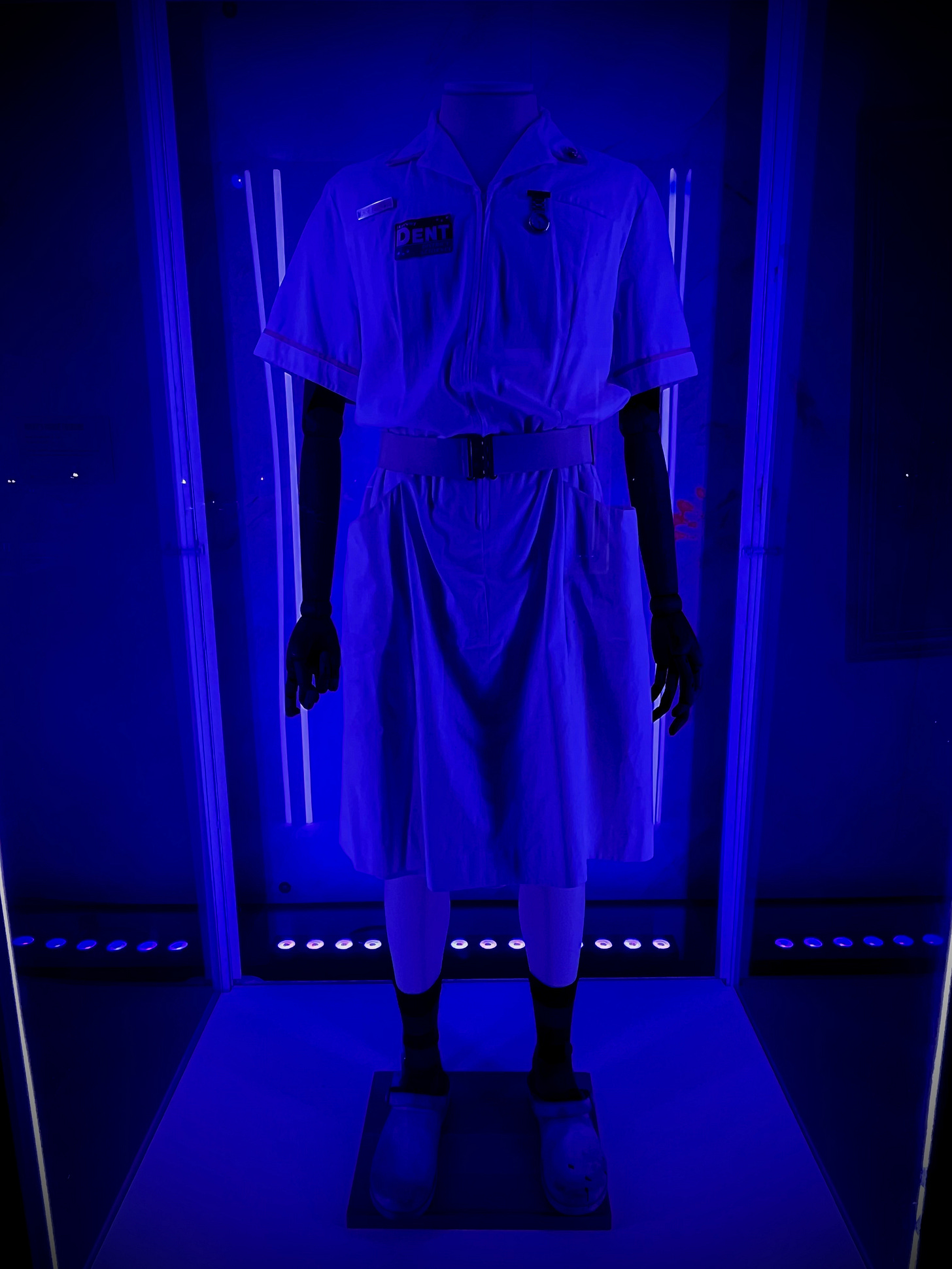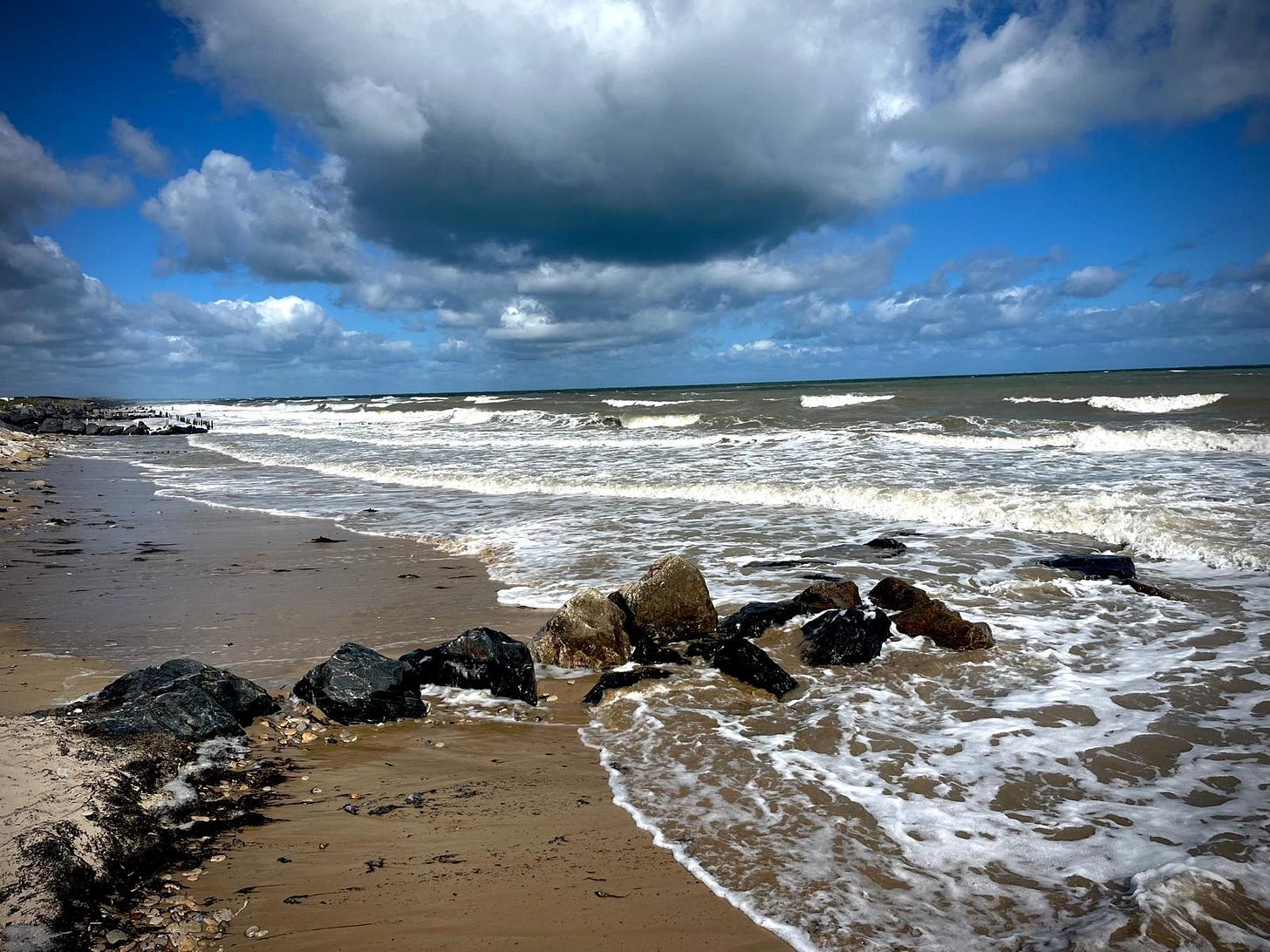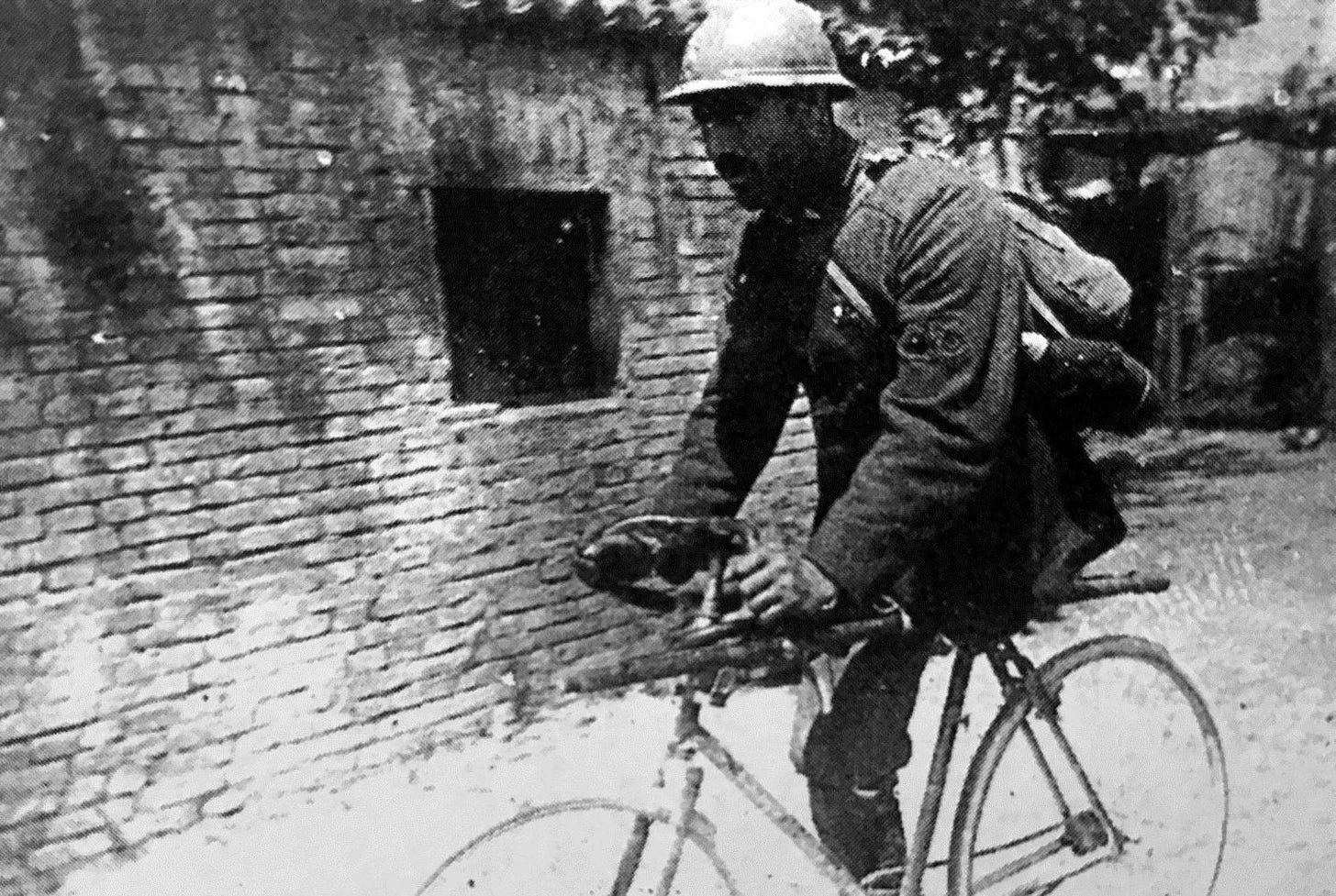Here’s your weekly, free roundup of everything that has been going on in my history world…
On the Road
Here’s one from left field. Currently in London, there is an exhibition running which celebrates the history of Batman. The do-gooding hero is 85 years old in 2024, and DC have put up relics and props, costumes etc. from every film featuring the Dark Knight, and much fun was had looking through it all yesterday…
My favourite exhibits included Christian Bale’s bat-pod bike thing, (above) from the 2000s, and Tom Hardy’s Bane mask (below). Yes, plenty of attention is given to the Batmobile, and there is one on display, but I’m not telling you from which film!
They also have an extensive collection of ‘cowls’ on display, this one was made for Michael Keaton and was worn in the 1989 film which gave me nightmares when I was little.
The walk through exhibition includes several mind-bending rooms based on various villains which are disorientating and fun to explore…
One take away from this? Joaquin Phoenix is a tiny person. As in, he can’t be any taller than me. His costume is smaller than Margot Robbie’s Harley Quinn outfit, which is also on display.
As well as piles of Batman’s tech innovations from across the decades, there’s levity in Arnold Schwarzenegger’s Mr Freeze slippers from 1997.
But it’s also moving to see Heath Ledger’s heist mask and his nurses’s outfit. Knowing what the role of the joker did to his mental health and what happened so soon after filming.
I highly recommend this for a bit of Hollywood history. My one regret? There’s nothing of the 1960s TV series I had so much fun watching re-runs of when I was a kid.
If you are interested in visiting this exhibition for yourself, go to: https://batmanexhibition.com
Do note though, this is a touring exhibition, so it may be coming closer to home for you at some stage. It will be in London till the end of the year.
Coming Up
Next weekend Kate Jamieson and I will be at Portsmouth Dockyard for one of our bestselling tours that take in centuries of naval history. There are still some places available. You’ll tour Mary Rose with me, HMS Victory with Kate, and then we’ll all recreate Nelson’s last walk on English soil on our way to the pub, where we’ll toast the man himself.
We’ve also launched our D-Day tour for next July. I’ll be leading this one, and we’ll be taking in nearly a week of sites and stories as we follow the course of D-Day and the Battle for Normandy in 1944. For more details, click on the picture below:
This Week
On Monday I wrote about an amputee who wouldn’t take no for an answer in any aspect of his life, and what happened when Italy declared war in 1915 and he made several, initially fruitless attempts to join the army…
Last week our mini bus was passing through the town of Cassino on its way to the monastery in search of WW2 stories, when we passed a statue of a one legged man waving a crutch. We were getting out anyway, to look at a Sherman nearby, and so with the most diligent of my nerds in tow, I went in search of this unique monument to see what it was all about. What we found was an almost unbelievable story of an amputee who refused to let a workplace accident get in the way of anything he wanted to do…
The statue we chanced upon in Cassino
Enrico Toți was a Roman. (His dad was apparently from Cassino, hence the statue) Born in 1882, he initially spent a few years in the navy before he followed in his father’s footsteps and worked on the railways. In March 1908, he was working between two locomotives at Colleferro station when he slipped and became trapped between gears. His leg was mangled, and had to be amputated at the pelvis. Now out of a job, Toti dabbled in inventing. He also refused to let his accident impinge on his active lifestyle. A competitive cyclist, swimmer and boxer before the accident, he continued to ride recreationally, and apparently remained a competitive swimmer against some of the best in Rome. And although he could no longer box, his upper body strength enabled him to rip decks of cards in half.
In 1911, Toti got on a bicycle and left Italy on a tour that took him via France, Belgium, the Netherlands, Denmark, Finland, Russia and Poland, returning to Italy in June 1912. In January 1913 he set off again, this time he made for Africa, and from Alexandria rode all the way to the Sudan before the British authorities sent him back to Cairo for safety reasons.
On the outbreak of war, Toti had multiple applications to join the army turned down, so once again he got on his bicycle and made for the front. As a civilian volunteer, he was assigned a non-combatant role until he was sent home having been cornered by a patrol who noticed his disability. Eventually, the Duke of Aosta intervened on his behalf, and at the beginning of 1916, Toti was sent as a civilian volunteer to the Acqui Brigade. From there, he managed to get a transfer to a Bersaglieri cyclist battalion, who accepted him willingly as a soldier and presented him with an old plumed helmet.
During the Sixth Battle of the Isonzo in August, Toti was killed east of Monfalcone, and the legend was born. Here’s one account:
“In broad daylight we overcame the enemy barrier in the open. At about three o'clock on 6th August, we reached Hill 85 (in the Sablici area). The order to advance came immediately and Enrico was among the first. He had traveled 50m when the first bullet hit him. I approached while we were both in the open. He did not want to take cover. He continued to throw bombs, and to do this he had to get up from the ground. That's how he took a second bullet to the chest. I thought he was dead. I moved forward, pulling him by the leg, but he kicked. Suddenly he stood up on his torso and grabbed his crutch and threw it towards the enemy. A bullet, this time the last, hit him in the forehead.’
He received the Italian Gold Medal of Valour, the equivalent to a VC or the Medal of Honour, and this was the citation:
‘Although missing his left leg, after having rendered important services in the feats of arms of April at Hill 70 (east of Selz), on 6th August, in the battle that led to the occupation of Hill 85, he boldly threw himself onto the enemy trench, continuing to fight with ardour, although already wounded twice. Hit to death by a third bullet, with heroic exultation he threw his crutch to the enemy and died kissing his feather, with stoicism worthy of that highly Italian soul.’
There’s some controversy about how much of this is true, as in the aftermath of the war, Mussolini had a propaganda field day with Toti, but he is certainly worthy of acclaim. As I was digging around for information, I came across an article that I wanted to share. Entitled The Tale of Toti, it was written by a journalist named Gino Speranza in collaboration with Lewis R. Freeman for The Atlantic in October 1918. He was well placed to write it, as it turns out he paid a visit to Enrico Toti’s family in Rome shortly after the hero’s death, and this is what he had to say…
To see the full story visit:
On Thursday it was monthly feature time…
Last month I gave you the first part of what is turning out to be a mammoth feature about the war service of one of the most beautiful ships ever built: Cunard White Star’s Queen Mary. I looked at the initial work the ship carried out transporting troops from Australia, what life was like on her, and about some of the shenanigans men (and women) got up to for the month or so they were on board…
…James Blackburn also remembered the cursory escort that the ship received when she came in and out of ports. ‘When we set off there were about three destroyers, but they were going up and down like corks… to must have been terrible trying to keep up.’ He’d hit on something significant here. Once the Queen Mary got away from the coast, she relied on sheer speed to outrun the enemy, which was sound. However, arguably it was the Mary herself that was the danger when she was surrounded by slower vessels. Gustave Thaler remembered watching in amazement as part of a protective screen on HMAS Voyager as the Queen Mary departed the entrance to the Suez Canal in 1941 with her sister, the Queen Elizabeth:
‘When they were ready to sail again, we escorted them down the gulf… we were doing a fairly high speed, and when the queens were out of bomber danger they started to put the foot down and they just flew through the screen… they left us for dead.’
More than one sailor had pondered what would happen if they happened to wander into the path of one of these charging liners. In 1941, Benjamin Fuller was serving on HMS Cornwall in the Middle East:
’We found ourselves convoying the Queen Elizabeth and the Queen Mary. We used to go down and pick them up… [ in the Indian Ocean] Then we’d take them up to the Red Sea… On one occasion we were going up, and I was working in the naval stores office, and suddenly the ship heeled over, and there was a terrific blast of a siren. It was Queen Mary… she was coming up fast to overtake us and we just missed having a collision.’
Within a year, however, another incident occurred and this time, there was no narrow escape. In October 1942, Reginald Coaker was serving aboard the destroyer HMS Bramham:
‘We went out, there were six of us, and the idea was that we went out to greet the Queen Mary, who was bringing American soldiers to Britain. I can remember Mary lolloping along, quite a sea-going. I had had my tot of rum and gone up on deck… I was talking to one of the guns crew up there and we looked and saw astern… the Queen Mary coming up on the horizon… with her was the cruiser, the Curacoa… She was going on short lengths of a zig-zag, and she was doing this at high speed, and the Curacoa being one of the older cruisers kept on a straight course… As we were looking back at her, they seemed to come close together… we suddenly looked across and said, “good god, look at what’s happened!” A great column of smoke suddenly went up… and we thought she’s been hit, we thought there had been a submarine and we’d missed it. Then the Queen Mary seemed to separate, then we thought we could see what we thought was the conning tower of a submarine.’
HMS Curacoa (Wikipedia)
There was no submarine. What Coaker and his companion were looking at was not a conning tower. It was the stern of the Curacoa, which had been cleaved in two by the Queen Mary. A survivor from the engine room later recounter to Coaker what had happened:
‘He had just finished lunch… he went down into the workshop, put his overalls on and went to the lathe he was working on, and just as he was starting work he thought there was something wrong with the motor because there was a jolt and a rush… “a tearing sound and this great scraping noise… then it was the sight of the Queen Mary that I saw going through the compartment.” Then he found himself out in the water, and there he was swimming for his life.’
Elsewhere on board the Curacoa, Henry Bell later claimed he had seen this coming. ‘We always said about the Queen Mary, she’ll cut us in half one of these days,’ he claimed, ‘because she always used to go close to our stern or close to our bows, where the Queen Elizabeth used to give us a wide berth.’ He was on watch when the collision came. ‘There was such a crash we thought we’d been torpedoed.’ Ted Wilson had just gone below:
‘There was a big swell on, because there had been a big storm a day or two previously, and I’d come off the morning watch… I went to get a bath in a bucket in the bathroom and I started doing some washing… All of a sudden there was a big crash, the lights went out, and I grabbed hold of the bathroom door. We nearly turned turtle right over onto our starboard side, the port side was up where the head should have been.’
Those on the bridge of HMS Bulldog also had a terrifying view of the collision, and of Queen Mary fleeing the scene. ’She never even halted,’ recalled David Walker on Bulldog:
‘You can imagine what our skipper said, he turned the air blue… we stayed with the Queen Mary, she made a signal to us, she said the Curacoa turned the wrong way… we detailed other destroyers to pick up survivors… we managed to get her into the Firth of Clyde safe, but she never even halted, stopped or slowed down. That was the priority. Absolutely, absolutely. Get her into port with all the soldiers she had on board.’
But the Curacao’s crew numbered nearly 500 men, and their ship had vanished from under them. Ted Wilson was faced with the terrifying possibility of being trapped below decks as she sank:
‘Gradually the ship started righting itself, but it still had a list to starboard… Some stokers started running back to where I was because there was a ladder up to the next deck, but the ladder wasn’t fixed down and it had gone up to the ceiling. We pulled it down, and by that time water was rushing down the ladder. We got up to the sickbay and it was coming nearly waist high.’
To read the rest of the story, visit:
Next Week
Stay tuned for a gruesome tale from Germany 1900, where we look at what happens when hateful rhetoric damages the fabric of society and people lose their minds. There’s also the story of more Nazi awfulness in Italy, this time in relation to an Italian war hero with an incredible record and his run-in with the SS in 1943/44.






















What a story about Toti , an inspirational figure, surprised a film hasn’t been made about him .
Holy Batman exhibition AC … Kerrpoww awesome with you on the 60’s Batman - That version of the Batmobile the groovy computers in the Bat Cave, Alfred, Irish cop promoted Commissioner Gordon, racy cat woman, the Riddler! …. Love the shots from the exhibition you just posted 🦇